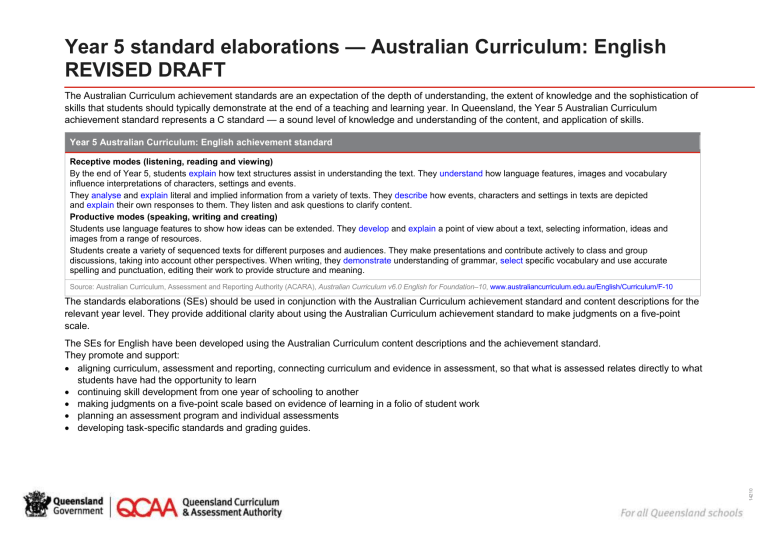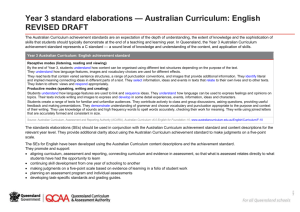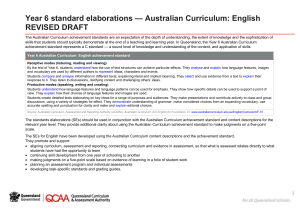Year 5 English standard elaborations

Year 5 standard elaborations — Australian Curriculum: English
REVISED DRAFT
The Australian Curriculum achievement standards are an expectation of the depth of understanding, the extent of knowledge and the sophistication of skills that students should typically demonstrate at the end of a teaching and learning year. In Queensland, the Year 5 Australian Curriculum achievement standard represents a C standard — a sound level of knowledge and understanding of the content, and application of skills.
Year 5 Australian Curriculum: English achievement standard
Receptive modes (listening, reading and viewing)
By the end of Year 5, students explain how text structures assist in understanding the text. They understand how language features, images and vocabulary influence interpretations of characters, settings and events.
They analyse and explain literal and implied information from a variety of texts. They describe how events, characters and settings in texts are depicted and explain their own responses to them. They listen and ask questions to clarify content.
Productive modes (speaking, writing and creating)
Students use language features to show how ideas can be extended. They develop and explain a point of view about a text, selecting information, ideas and images from a range of resources.
Students create a variety of sequenced texts for different purposes and audiences. They make presentations and contribute actively to class and group discussions, taking into account other perspectives. When writing, they demonstrate understanding of grammar, select specific vocabulary and use accurate spelling and punctuation, editing their work to provide structure and meaning.
Source: Australian Curriculum, Assessment and Reporting Authority (ACARA), Australian Curriculum v6.0 English for Foundation
–10
, www.australiancurriculum.edu.au/English/Curriculum/F-10
The standards elaborations (SEs) should be used in conjunction with the Australian Curriculum achievement standard and content descriptions for the relevant year level. They provide additional clarity about using the Australian Curriculum achievement standard to make judgments on a five-point scale.
The SEs for English have been developed using the Australian Curriculum content descriptions and the achievement standard.
They promote and support:
aligning curriculum, assessment and reporting, connecting curriculum and evidence in assessment, so that what is assessed relates directly to what students have had the opportunity to learn
continuing skill development from one year of schooling to another
making judgments on a five-point scale based on evidence of learning in a folio of student work
planning an assessment program and individual assessments
developing task-specific standards and grading guides.
Year 5 English standard elaborations
A B
The folio of student work has the following characteristics:
C D
Considered analysis of information in texts to explain literal and implied meaning
Effective analysis of information in texts to explain literal and implied meaning
Analysis of information in texts to explain literal and implied meaning
Identification of literal meaning in texts
REVISED DRAFT
E
Restatement of information from texts
Considered description of how characters, events and settings in texts are represented
Effective description of how characters, events and settings in texts are represented
Description of how characters, events and settings in texts are represented
Identification of representations of characters, events and settings in texts
Identification of characters, events and settings in texts
Considered explanation of own perspectives on events, characters and settings in a variety of texts
Effective explanation of own perspectives on events, characters and settings in a variety of texts
Considered explanation of how text structures are used for different purposes
Effective explanation of how text structures are used for different purposes
Explanation of own perspectives on events, characters and settings in a variety of texts
Description of own response to events, characters and settings in a variety of texts
Identification of own response to events, characters and settings in a variety of texts
Explanation of how text structures are used for different purposes
Description of aspects of text structures and purposes
Identification of aspects of text structures
Considered explanation of how language features, images and vocabulary are used for different purposes and effects, including influencing interpretations of characters, settings and events
Effective explanation of how language features, images and vocabulary are used for different purposes and effects, including influencing interpretations of characters, settings and events
Explanation of how language features, images and vocabulary are used for different purposes and effects, including influencing interpretations of characters, settings and events
Description of language features, images and vocabulary used for different purposes, including representations of characters, settings and events
Identification of language features, images and vocabulary
Year 5 standard elaborations
— Australian Curriculum: English
REVISED DRAFT
Queensland Curriculum & Assessment Authority
July 2014
Page 2 of 6
A B C
The folio of student work has the following characteristics:
Considered selection and use of ideas, information and images for different purposes, including to develop and explain a point of view
Effective selection and use of ideas, information and images for different purposes, including to develop and explain a point of view
Selection and use of ideas, information and images for different purposes, including to develop and explain a point of view
D E
Use of ideas, information and images for different purposes, including to develop a point of view
Use of ideas and information, including to state an opinion
Considered use of text structures for different purposes and audiences, including making presentations
Effective use of text structures for different purposes and audiences, including making presentations
Considered use of a variety of language features for different purposes. Language features include:
• grammatical structures
• vocabulary
• spoken/signed features 1
• non-verbal features 2
• visual features 3
Use of text structures for different purposes and audiences, including making presentations
Use of aspects of text structures for different purposes, including making presentations
Effective use of a variety of language features for different purposes.
Language features include:
• grammatical structures
• vocabulary
• spoken/signed features
• non-verbal features
• visual features
Use of a variety of language features for different purposes.
Language features include:
• grammatical structures
• vocabulary
• spoken/signed features
• non-verbal features
• visual features
Use of language features that vary in suitability, for example:
• grammatical structures
• vocabulary
• spoken/signed features
• non-verbal features
• visual features
Use of aspects of text structures, including to make a presentation
Use of language features that impede meaning, for example:
• grammatical structures
• vocabulary
• spoken/signed features
• non-verbal features
• visual features
1
For example: pronunciation; pace, phrasing and pausing; audibility and clarity
2 For example: facial expressions, gestures, proximity, stance, movement
3 For example: graphics, still and moving images
Year 5 standard elaborations
— Australian Curriculum: English
REVISED DRAFT
Queensland Curriculum & Assessment Authority
July 2014
Page 3 of 6
Considered use of editing strategies to improve meaning and structure, including:
• accurate spelling
• punctuation
• selection of language features
Effective use of editing strategies to improve meaning and structure, including:
• accurate spelling
• punctuation
• selection of language features
Use of editing strategies to improve meaning and structure, including:
• accurate spelling
• punctuation
• selection of language features
Use of editing strategies that vary in suitability, for example:
• spelling
• punctuation
• selection of language features
Use of textual features that impede meaning, for example:
• spelling
• punctuation
• selection of language features
Note: Colour highlights have been used in the table to emphasise the qualities that discriminate between the standards.
Year 5 standard elaborations
— Australian Curriculum: English
REVISED DRAFT
Page 4 of 6
Queensland Curriculum & Assessment Authority
July 2014
Notes
The SEs describe the qualities of achievement in the two dimensions common to all Australian
Curriculum learning area achievement standards:
understanding
skills.
Dimension *
Understanding*
Description
The concepts underpinning and connecting knowledge in a learning area, related to a student’s ability to appropriately select and apply knowledge to solve problems in that learning area
The specific techniques, strategies and processes in a learning area Skills*
The following terms and key words are used in the Year 5 English SEs. They help to clarify the descriptors and should be used in conjunction with the ACARA Australian Curriculum English glossary: www.australiancurriculum.edu.au/english/Glossary
Term
Analysis; Analyse*
Description
Consider in detail for the purpose of finding meaning or relationships, and identifying patterns, similarities and differences
Particular parts or features Aspects
Considered;
Consideration*
Thought about deliberately with a purpose
Description; Descriptive;
Describe*
Effective
Give an account of characteristics or features
Capably meets the described requirements
Explanation: Explanatory;
Explain*
Provide additional information that demonstrates understanding of reasoning and/or application
Establish or indicate who or what someone or something is Identification; Identify*
Implied meaning Suggested but not directly expressed. The following information is provided to support working with ‘implied meaning’.
Information and ideas in texts may be:
• interpreted to identify relationships among ideas, information, facts and values. These relationships include comparisons, and cause and effect
• combined with prior experience to extrapolate on what is in the text
• analysed to judge the logic of the text to, for example, identify particular points of view represented or fallacies inherent in the text
• evaluated to make judgments using criteria
• synthesised with literal meaning and other types of implied meaning to respond to an idea or thesis with creative thinking
Interpretation; Interpret* Explaining the meaning of information or actions
* The asterisk (*) denotes dimensions and terms described by ACARA. Unmarked terms are described by QCAA.
Year 5 standard elaborations
— Australian Curriculum: English
REVISED DRAFT
Page 5 of 6
Queensland Curriculum & Assessment Authority
July 2014
Literal meaning
Perspectives
Restatement; Restate
Selection; Select*
Statement; State
Synthesis: Synthesise*
Text*
Use of
Variety
Taking words in their exact or most basic sense without metaphor or exaggeration. The following information is provided to support working with ‘literal meaning’.
Information and ideas in texts may be:
• recognised or recalled
• translated or changed into a different form by, for example, paraphrasing or restating
Ways of regarding situations, facts and texts
Repeat known information
Choose in preference to another or others
A sentence or assertion
Combine elements (information/ideas/components) into a coherent whole
The means for communication. Their forms and conventions have developed to help us communicate effectively with a variety of audiences for a range of purposes. Texts can be written, spoken or multimodal and in print or digital/online forms.
Information about spoken texts in the Year 5 Australian Curriculum:
English achievement standard makes clear that students should have opportunities to:
• contribute actively to class and group discussions, taking into account other perspectives
• listen and ask questions to clarify content
To operate or put into effect
A number of different things
Year 5 standard elaborations
— Australian Curriculum: English
REVISED DRAFT
Page 6 of 6
Queensland Curriculum & Assessment Authority
July 2014








